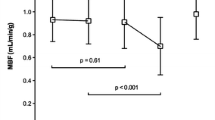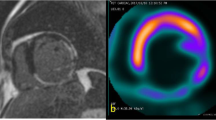Abstract
This study assessed the accuracy and feasibility of magnetic resonance imaging (MRI) during a constant infusion of gadolinium diethylenetriaminepentaacetic acid (Gd-DTPA) for the determination of myocardial viability in patients with recent acute myocardial infarction (AMI). Nine patients were studied within 10 days of AMI. Rest-redistribution201Thallium (201Tl) single photon emission computed tomography (SPECT) was used as a gold standard for viability. Using MRI, regional perfusion was assessed using dynamic imaging during a bolus injection of Gd-DTPA and viability was assessed during a continuous infusion. Finally, cine MR images were acquired at baseline, during low-dose dobutamine infusion and after recovery. To assess viability, the left ventricle was divided into 16 segments and signal intensity in corresponding MRI and redistribution SPECT segments were compared. Wall thickening index (WTI) was determined at each step during the dobutamine study. The results revealed that in five patients, reduced perfusion in infarcted regions was observed qualitatively during dynamic first pass imaging. There was a significant inverse correlation between201Tl uptake and MRI signal intensity, i.e. infarcted tissue (low201Tl uptake) had increased MR signal intensity. Segments were separated into normal (201Tl uptake >90%) and infarcted (<60%). Infarcted MRI segments had greater signal intensity than normal segments (179±50 vs. 102±14%;P<0.0001). WTI in normal segments increased by 18±8.5% (P<0.0001) from baseline to 10 µg/kg per min of dobutamine while infarcted tissue WTI decreased 2.8±7.2% (P=0.17). Thus regions of myocardium that were infarcted as defined by reduced201Tl uptake and absent contractile reserve showed greatly increased MRI signal intensity during a constant infusion of Gd-DTPA. The use of MRI during a constant infusion of Gd-DTPA is accurate and feasible for the determination of myocardial necrosis in a clinical setting.
Similar content being viewed by others
Abbreviations
- AMI:
-
acute myocardial infarction
- EKG:
-
electrocardiogram, electrocardiographic
- Gd-DTPA:
-
gadolinium diethylenetri-aminepentaacetic acid
- MRI:
-
magnetic resonance imaging
- PET:
-
positron emission tomography
- SPECT:
-
single photon emission computed tomography
- TE:
-
MRI echo time
- 201Tl:
-
201Thallium
- TR:
-
MRI repetition time
- T1 :
-
MRI spin-lattice relaxation time
- T2 :
-
MRI spin-spin relaxation time
- WTI:
-
wall thickening index
References
Morse RW, Noe S, Caravalho J, Jr. Balingit A, Taylor AJ. Rest-redistribution201Tl single-photon emission CT for determination of myocardial viability. Relationship among viability, mode of therapy and long-term prognosis. Chest 1999;115:1621–6.
Volpi A, DeVita C, Franzosi MG, Geraci E, Maggioni AP, Maurri F, Negri E, Santoro E, Tavazzi L, Tognoni G. Determinants of 6 month mortality in survivors of myocardial infarction after thrombolysis. Results of the GISSI-2 data base. Circulation 1993;88:416–29.
Lieberman AN, Weiss JL, Jugdutt BI, Becker LC, Bulkley BH, Garrison JH, Hutchins GM, Kallman CA, Weisfeldt ML. Twodimensional echocardiography and infarct size: Relationship of regional wall motion and thickening to the extent of myocardial infarction in the dog. Circulation 1981;63:739–45.
Dilsizian V, Bonow RO. Current diagnostic techniques of assessing myocardial viability in patients with hibernating and stunned myocardium. Circulation 1993;87(1):1–20.
Bonow RO, Dilsizian V, Cuocolo A, Bacharach SL. Identification of viable myocardium in patients with chronic coronary artery disease and left ventricular dysfunction. Comparison of thallium scintigraphy with reinjection and PEI imaging with18F-fluorodeoxyglucose. Circulation 1991;83:26–37.
Dilsizian V, Perrone-Filardi P, Arrighi JA, Bacharach SL, Quyyumi AA, Freedman NMT, Bonow RO. Concordance and discordance between stress-redistribution-reinjection and rest-redistribution thallium imaging for assessing viable myocardium. Comparison with metabolic activity by positron emission tomography. Circulation 1993;88:941–52.
Piérard LA, DeLandsheere M, Berthe C, Rigo P, Kulbertus HE. Identification of viable myocardium by echocarhography during dobutamine infusion in patients with myocardial infarction after thrombolytic therapy: comparison with position emission tomography. JACC 1990;15:1021–31.
Elhendy A, Trocino G, Salustri A, Cornel JH, Roelandt JRTC, Boersma E, van Domburg RT, Krenning RP, El-Said GM, Fioretti PM. Low-dose dobutamine echocardiography and rest-redistribution thallium-201 tomography in the assessment of spontaneous recovery of left ventricular function after recent myocardial infarction. Am Heart J 1996;131:1088–96.
Pereira RS, Prato FS, Wisenberg G, Sykes J. The determination of myocardial viability using Gd-DTPA in a canine model of myocardial ischemia and reperfusion. Magn Reson Med 1996;36:684–93.
Pereira RS, Prato FS, Sykes J, Wisenberg G. Assessment of myocardial viability using MRI during constant infusion of Gd-DTPA: further studies at early and later periods of reperfusion. Magn Reson Med 1999;42:60–8.
Pereira RS, Prato FS, Lekx KS, Sykes J, Wisenberg G. Contrastenhanced MRI for the clinical assessment of myocardial viability after permanent coronary artery occlusion. Magn Reson Med 2000;44:309–16.
Lima JAC, Judd RM, Bazille A, Schulman SP, Atalar E, Zerhouni EA. Regional heterogeneity of human myocardial infarcts demonstrated by contrast-enhanced MRI: potential mechanisms. Circulation 1995;92:1117–25.
Arheden H, Bremerich J, Saeed M, Wyttenbach R, Higgins CB, Dae MW, Gao DW, Wendland MF. Measurement of the distribution volume of gadopentetate dimeglumine at echo-planar MR imaging to quantify myocardial infarction: comparison with 99mTc-DTPA autoradiography in rats. Radiology 1999;211:698–708.
Judd RM, Lugo-Olivieri CH, Arai M, Kondo T, Croisille P, Lima JAC, Mohan V, Becker LC, Zerhouni EA. Physiological basis of myocardial contrast enhancement in fast magnetic resonance images of 2-day-old reperfused canine infarcts. Circulation 1995;92:1902–10.
Tong CY, Prato FS, Wisenberg G, Lee TY, Carroll E, Sandler D, Wills J. Techniques for the measurement of the local myocardial extraction efficiency for inert diffusible contrast agents such as gadopentate dimeglumine. Magn Reson Med 1993;30:332–6.
Diesbourg LD, Prato FS, Wisenberg G, Drost DJ, Marshall TP, Carroll SE, O’Neill B. Quantification of myocardial blood flow and extracellular volumes using a bolus injection of Gd-DTPA: kinetic modeling in canine ischemic heart disease. Magn Reson Med 1992;23:239–53.
Sciagra R, Santoro GM, Bisi G, Pedenovi P, Fazzini PF, Pupi A. Rest-redistribution thallium-201 SPECT to detect myocardial viability. JNM 1998;39:384–90.
Foo TKF, Bernstein MA, Aisen AM, Hernandes RJ, Collick BD, Bernstein T. Improved ejection fraction and flow velocity estimates with use of view sharing and uniform repetition time excitation with fast cardiac techniques. Radiology 1995;195:471–8.
Jerosch-Herold M, Wilke N, Stillman AE, Wilson RF. Magnetic resonance quantification of the myocardial perfusion reserve with a Fermi function model for constrained deconvolution. Med Phys 1998;25:73–84.
Manning WJ, Atkinson DJ, Grossman W, Paulin S, Edelman RR. First-pass nuclear magnetic resonance imaging studies using Gd-DTPA in patients with coronary artery disease. JACC 1991;18:959–65.
Walsh EG, Doyle M, Lawson MA, Blackwell GG, Pohost GM. Multislice first-pass nyocardial perfusion imaging on a conventional clinical scanner. Magn Reson Med 1995;34:39–47.
Lauerma K, Virtanen K, Sipilä LM, Hekali P, Aronen HJ. Multislice MRI in assessment of myocardial perfusion in patients with single-vessel proximal anterior descending coronary artery disease before and after revascularization. Circulation 1997;96:2859–67.
van Rugge FP, van der Wall EE, Spanjersberg SJ, de Roos A, Matheijssen NAA, Zwinderman AH, Dijkman PRM, Reiber JHC, Bruschke AVG. Magnetic resonance imaging during dobutamine stress for detection and localization of coronary artery disease. Quantitative wall motion analysis using a modification of the centerline method. Circulation 1994;90:127–38.
Baer FM, Voth E, Schneider CA, Theissen P, Schicha H, Sechtem U. Comparison of low-dose dobutamine-gradient-echo magnetic resonance imaging and positron emission tomography with [18F]tluorodeoxyglucose in patients with chronic coronary artery disease. A functional and morphological approach to the detection of residual myocardial viability. Circulation 1995;91:1006–15.
Robb RA, Hanson DP. The ANALYZE software system for visualization and analysis in surgery simulation. In: Lavalle S. Taylor R, Burdea G, Mosges R, editors. Computer Integrated Surgery. Cambridge, MA: MIT Press, 1995.
Lima JAC, Jeremy R, Guier W, Bouton S, Zerhouni EA, McVeigh E, Buchalter MB, Weisfeldt ML, Shapiro EP, Weiss JL. Accurate systolic wall thickening by nuclear magnetic resonance imaging with tissue tagging: correlation with sonomicrometers in normal and ischemic myocardium. JACC 1993;21:1745–51.
Zar JH. Biostatistical Analysis. Englewood Cliffs, NJ: Prentice Hall, 1984.
Kaul S. Assessing the myocardium after attempted reperfusion. Should we bother? Circulation 1998;98:625–7.
Iskander S, Iskandrian AE. Prognostic utility of myocardial viability assessment. Am J Cardiol 1999;83:696–702.
Jerosch-Herold M, Wilke N, Stillman AE. Magnetic resonance quantification of the myocardial perfusion reserve with a Fermi function model for constrained deconvolution. Med Phys 1998;25:73–84.
Bergmann SR, Herrero P, Markham J, Weinheimer CJ, Walsh MN. Noninvasive quantitation of myocardial blood flow in human subjects with oxygen-15-labeled water and positron emission tomography. JACC 1989;14:639–52.
Vallée J-P, Sostman HD, MacFall JR, Coleman RE. Quantification of myocardial perfusion with MRI and exogenous contrast agents. Cardiology 1997;88:90–105.
Tong CY, Prato FS. A novel fast T-mapping method. JMRI 1994;4:701–8.
McKenzie CA, Pereira RS, Chen Z, Pratu FS, Drost DJ. Improved contrast agent bolus tracking using T1 FARM. Magn Reson Med 1999;41:429–35.
Larsson HBW, Fritz-Hansen T, Rostrup E, Sondergaard L, Ring P, Henriksen O. Myocardial perfusion modeling in MRI. Magn Reson Med 1996;35:716–26.
Johnston DL, Homma S, Liu P, Weilbaecher DG, Rokey R, Brady TJ, Okada RD. Serial changes in nuclear magnetic resonance times after myocardial infarction in the rabbit: Relationship to water content, severity of ischemia and histopathology over a six-month period. Magn Reson Med 1988;8:363–79.
Schwitter J, Saeed M, Wendland MF, Derugin N, Canet E, Brasch RC, Higgins CB. Influence of severity of myocardial injury on distribution of macromolecules: extravascular versus intravascular gadolinium-based magnetic resonance contrast agents. JACC 1997;30:1086–94.
Barilla G, Gheorghiade M, Alam M, Khaja F, Goldstein S. Low-dose dobutamine in patients with acute myocardial infarction identifies viable but not contractile myocardium and predicts the magnitude of improvement in wall motion abnormalities in response to coronary reascularisation. Am Heart J 1991;122:1522–31.
Marcovitz PA, Shayna V, Horn RA, Hepner A, Armstrong WF. Value of dobutamine stress echocardiography in determining the prognosis of patients with known or suspected coronary artery disease. Am J Cardiol 1996;78:404–8.
Dendale PAC, Franken PR, Waldman GJ, De Moor DGE, Tombeur DAM, Block PFC, De Roos A. Low-dosage dobutamine magnetic resonance imaging as an alternative to echocardiography in the detection of viable myocardium after acute infarction. Am Heart J 1995;130:134–40.
DePuey EG, Rozanski A. Using gated technetium-99m-sestamibi SPECT to characterize fixed myocardial defects as infarct or artifact. JNM 1995;36:952–5.
Weissman NJ, Levangie MW, Newell JB, Guerrero L, Weyman AE, Picard MH. Effect of β-adrenergic receptor blockade on the physiologic response to dobutamine stress echocardiography. Am Heart J 1995;130:248–53.
Weissman NJ, Levangie MW, Guerrero JL, Weyman AE, Picard MH. Effect of β-blockade on dobutamine stress echocardiography. Am Heart J 1996;131:698–703.
Pennell DJ, Underwood SR, Manzara CC, Swanton RH, Walker JM, Ell PJ, Longmore DB. Magnetic resonance imaging during dobutamine stress in coronary artery disease. Am J Cardiol 1992;70:34–40.
Lethimonnier F, Furber A, Morel O, Geslin P, L’Hoste P, Tadei A, Jallet P, Caron-Poitreau C, Le Jeune JJ. Three-dimensional coronary artery MR imaging using prospective real-time respiratory navigator and linear phase shift processing: comparison with conventional coronary angiography. Magn Reson Imag 1999;17:1111–20.
Author information
Authors and Affiliations
Corresponding author
Rights and permissions
About this article
Cite this article
Pereira, R.S., Wisenberg, G., Prato, F.S. et al. Clinical assessment of myocardial viability using MRI during a constant infusion of Gd-DTPA. MAGMA 11, 104–113 (2000). https://doi.org/10.1007/BF02678473
Received:
Revised:
Accepted:
Published:
Issue Date:
DOI: https://doi.org/10.1007/BF02678473




